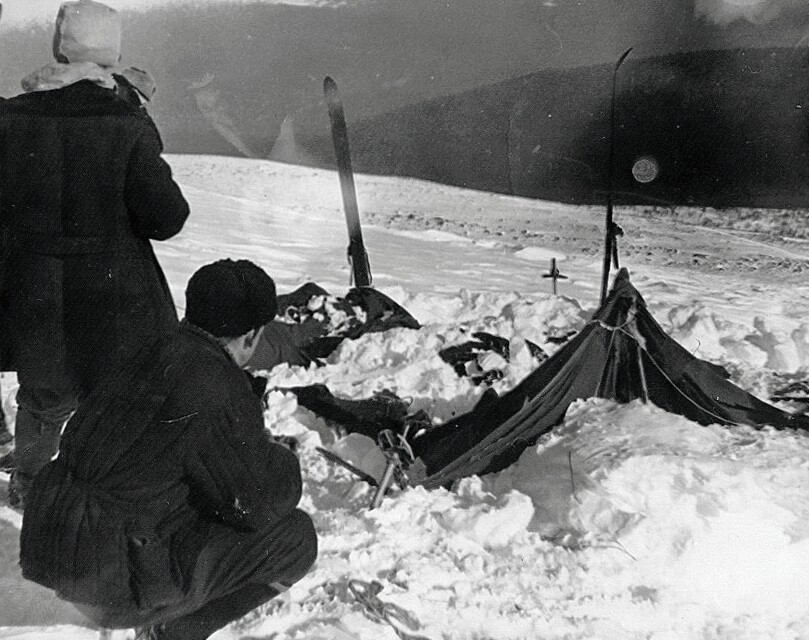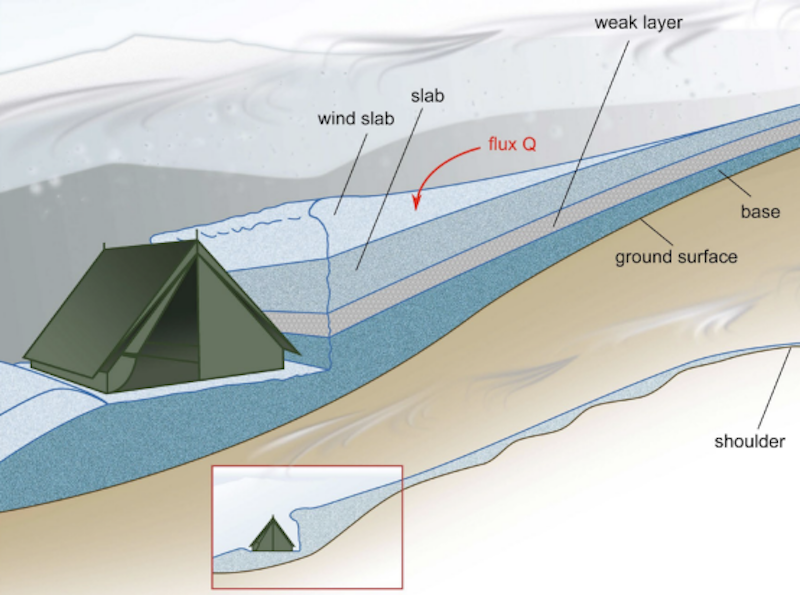
They were obviously hit by an avalanche and they survived the first such event. They cut themselves out of the tent and then scampered away in a panic. Downhill was a poor idea. It is also possible that the injuries were incurred in the tent, but the evidence supports a second flow catching the other four and throwing them into the ravine after they all reached the tree line. The survivors had a fire going and finally they tried to return to the tent to get their gear. The cold killed them quickly.
The temperature was likely around 50 below zero. You have minutes in those conditions without protection. That has never been commented on but they paniced and did not dig out all their survival kit before moving to cover. At the tree line they did get a fire started. That suggests they were all alive and figuring out what to do next. The fire was simply not enough to help much.
The second flow caught some of them and carried them into the ravine, likely killing them.
Nasty and another reminder of just how dangerous all avalanche slopes are.
Mystery Dyatlov Pass deaths may be explained by new scientific theory
January 28, 2021

The group preparing their tent before that fateful night in 1959
Dyatlov Memorial Foundation
VIEW 4 IMAGES
https://newatlas.com/science/dyatlov-pass-incident-mystery-new-theory/
In 1959, a group of Russian hikers died under mysterious circumstances – and their story, now known as the Dyatlov Pass incident, has intrigued the world ever since. There’s been no shortage of theories about what happened, but none have been able to fully explain all the weird details. Now a new study, backed up by simulations, suggests a snow slab avalanche is responsible.
On January 27, 1959, a group of 10 Russian hikers departed the village of Vizhai on a two-week expedition to Otorten mountain. In the height of winter, the route they were taking had been classified as a Category III, which is the most difficult and riskiest.
Only one of the hikers returned: Yuri Yudin, who turned back on the second day due to health issues. When the others failed to return after a few weeks, a search party was sent out to investigate – and they stumbled upon a grisly scene.
Their tent was found pitched on the side of a mountain called Kholat Syakhi. It had been cut open from the inside. None of the hikers were in the tent but their belongings, including their shoes, were. Outside, nine sets of footprints – barefoot or just clad in socks – were found in the snow, leading down to a patch of trees about 1.5 km (0.9 miles) away. And that’s where they found the first bodies.
The tent as it was discovered by the rescue team, a month after the hikers vanished
Dyatlov Memorial Foundation
Yuri Doroshenko and Georgiy Krivonischenko were found dead, dressed only in their underwear, near the remains of a small fire. Three other bodies were found between the tree line and the tent, and it was presumed that they had been trying to return to camp.
Medical examinations of these first five hikers revealed that they had all died of hypothermia. Tragic, but perhaps not surprising. However it wasn’t until the remaining four bodies were found, more than two months later, that the mystery deepened.
In a ravine just 246 feet further into the woods, the last four hikers were discovered. Three of them had been killed by serious injuries – one had major damage to his skull, and two others had suffered severe chest trauma. Forensic experts said that the force required to do that kind of damage was like that experienced when being hit by a car, but notably there were no external wounds. The official conclusion was that they’d died as the result of a “compelling natural force.”
So what happened that night? Why did the group leave their tent in such a hurry, and why didn’t they go back for their gear? How did the injuries occur, and why only to some hikers? The story has all the makings of an intriguing mystery, and in the 60 years since it’s attracted its fair share of theories, some of them pretty wild. Everything from natural disasters, to murder or a fight, to secret military experiments and (of course) aliens and yetis, have been blamed.
The Dyatlov Pass incident has been the subject of books, movies, documentaries, and podcasts for decades, and now a team of researchers from EPFL and ETH Zurich have put forward a new theory, which seems to explain the injuries.
Snow slab avalanche
A diagram illustrating the structure of the snow ahead of the avalanche. The section marked wind slab would have accumulated overnight, until the added weight fractured the weak layer and caused a snow slab to break off
Gaume/Puzrin
Right from the beginning of the investigation, an avalanche was suggested as one of the most plausible explanations. But it didn’t quite fit – there was no sign of debris or disturbance to the snow that an avalanche would create, and the hill the group had set up camp on wasn’t steep enough for one to occur. The trigger for the avalanche would have been the group making a cut in the slope to pitch their tent, but there was an unexplained nine-hour delay until the avalanche. And finally, it’s not clear how an avalanche could cause the type of injuries sustained.
But according to the researchers on the new study, this wasn’t your garden variety avalanche. It was what’s known as a slab avalanche, where a large solid block of snow breaks off from a deposit. This, the team says, could account for all of the above oddities.
“We use data on snow friction and local topography to prove that a small slab avalanche could occur on a gentle slope, leaving few traces behind,” says Johan Gaume, lead author of the study. “With the help of computer simulations, we show that the impact of a snow slab can lead to injuries similar to those observed. And then, of course, there’s the time lag between the team cutting into the slope and the triggering of the event. That’s the main focus of our article. Previous investigators have been unable to explain how, in the absence of any snowfall that evening, an avalanche could have been triggered in the middle of the night. We had to come up with a new theory to explain it.”
The key, according to the researchers, was a katabatic wind. This kind of airflow is known to rush downhill with some force, gradually depositing more snow uphill from the tent. The researchers simulated the dynamics of a snow-slab avalanche, including how long it could take to break off after a cut in the slope, aided by katabatic winds. They found that the conditions for the avalanche release could be met between 7.5 and 13.5 hours after the cut.
“If they hadn’t made a cut in the slope, nothing would have happened,” says Alexander Puzrin, co-author of the study. “That was the initial trigger, but that alone wouldn’t have been enough. The katabatic wind probably drifted the snow and allowed an extra load to build up slowly. At a certain point, a crack could have formed and propagated, causing the snow slab to release.”
The team ran simulations of the impact of a snow slab on the human body
Gaume/Puzrin
Next, the team simulated the potential damage a snow slab may do to a human body on impact. They found that the simulated snow slab reached a velocity of around 2 m/ (6.6 ft/s) by the time of impact, and at that speed a block of snow with a volume of 0.5 m3 and a density of 400 kg/m3 could have caused injuries consistent with what was recorded. It seems that the victims would have been caught between the falling slab and the compacted snow underneath the tent.
As intriguing as the study is, the team of course doesn’t claim to have solved the mystery entirely. After all, questions still remain – if the victims were killed or injured in the tent, why were their bodies found almost a mile away? It’s possible that the other group members fled before the avalanche hit, and moved their injured friends to safety. Or, the researchers suggest, perhaps they weren’t killed in the tent but in another snow-slab fall in the ravine where the bodies were found.
“The truth, of course, is that no one really knows what happened that night,” says Puzrin. “But we do provide strong quantitative evidence that the avalanche theory is plausible.”
Either way, we doubt we’ve heard the last conspiratorial podcast on the infamous Dyatlov Pass incident.
The research was published in the journal Communications Earth & Environment. The team describes the work in the video below.



No comments:
Post a Comment